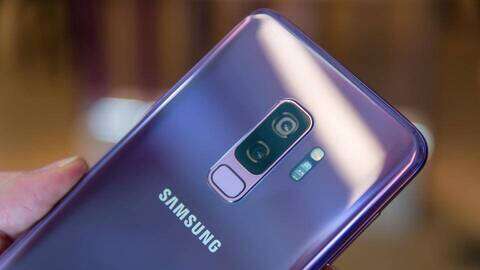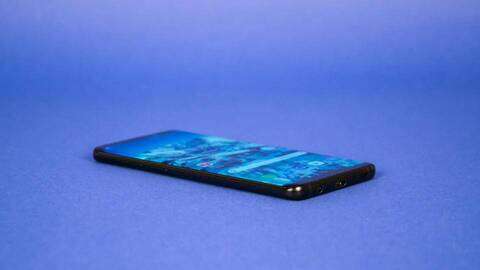Samsung Galaxy S9+ Samsung Galaxy S9 Plus review: A dual-camera delight
Plus-sized phones often find themselves stuck in a plus-sized niche – but Samsung’s Galaxy S9 Plus is different to most. This time around, it’s ready to steal the spotlight from the regular S9. And that’s because it has dual cameras at the rear, promising truly exceptional photographic capabilities, while the normal S9 continues to make do with one.
It’s not just about strength in numbers. The camera now has a variable aperture, which widens or narrows depending on the lighting conditions. And, as you’d expect, the S9 Plus has received a slight bump in processing power. These highlights aside, the S9 Plus doesn't bring much to the table that you haven't seen before. But it all adds up to one hell of a phone.
Samsung Galaxy S9 Plus review: What you need to know
The Galaxy S9 Plus is Samsung’s latest big-screened flagship. It looks similar to the Korean firm’s last Android beauty, with an edge-to-edge 6.2in QHD+ display on the front, the Samsung Exynos 9810 processor (or the latest Qualcomm Snapdragon 845 if you live in the US), 4GB of RAM and 128GB of storage, which is expandable via microSD.
The biggest change from last year’s effort is the dual 12-megapixel camera setup. This is a similar arrangement to the Galaxy Note 8, but this sensor is far more adept at low-light photography, with a wide, f/1.5 aperture, which I’ll discuss in more detail below.
Samsung Galaxy S9 Plus review: Price and competition
The Galaxy S9 Plus isn’t a wallet-friendly handset. Launching for £869 SIM-free , the S9 Plus is £90 more expensive than the Galaxy S8 Plus’ original launch price.

As for competition, there’s Apple’s iPhone X , which will set you back £1,000 , and Google’s Pixel 2 XL is yours for £799 . Last year’s Galaxy S8 Plus is around £700 on Amazon, and I’ve seen it drop as low as £649.
Best Samsung Galaxy S9 Plus contract and SIM-free deals
Samsung Galaxy S9 Plus review: Design and display
Samsung’s latest smartphones look a lot like the previous generation. The top and bottom bezels on the front of the S9 Plus handset have shrunk ever so slightly compared to the S8 Plus, but aesthetically there’s nothing new on show.
Don’t get me wrong, though: the S9 Plus is still a seriously impressive smartphone. The dominating, plus-sized display on the front makes a real statement. Measuring 6.2in from rounded corner to rounded corner, its bezel-less design is still a sight to behold. While the look isn’t as fresh as it was a year ago, my eyes still light up every single time one of these 18:9 beauties is unveiled.
The specs are the same as last year, so again we're talking about a 6.2in QHD+ (2,960 x 1,440) display. As usual, it benefits from Samsung’s Super AMOLED technology, so expect effectively perfect contrast levels and class-leading image quality.

And that’s precisely what our X-Rite colorimeter tells us. The S9 Plus’ display reached a perfect Infinity:1 contrast ratio, with an sRGB colour gamut coverage of 98% and a Delta E of 1.5, making for a screen that is capable of producing accurate, vibrant colours across the entire palette.
Maximum brightness is decent, too, reaching a peak of 302cd/m2 on manual mode. Flick on auto-brightness – which adapts the display brightness depending on the surrounding light levels – and the S9 Plus’ screen is capable of reaching a dazzling 810cd/m2.
Samsung Galaxy S9 Plus review: Performance and battery life
Behind the screen, however, Samsung has rung the changes. UK customers are served by Samsung’s own octa-core 2.7GHz Exynos 9810 processor, while those in other territories get Qualcomm’s similarly capable Snapdragon 845. There’s also 4GB of RAM for multitasking and 128GB of onboard storage, which is expandable up to 400GB via microSD.
And as for performance, well, it’s no surprise that the Galaxy S9 Plus is a seriously speedy smartphone. Running the Geekbench 4 multi- and single-core tests, Samsung’s flagship reached 8,848 and 3,629 respectively – one of the highest figures we’ve seen on an Android handset, only slightly pipped at the post by Apple’s iPhone 8 .
Likewise, graphics performance is top-notch. The S9 Plus breezed past the GFXBench Manhattan 3 test, scoring a 43fps average at native resolution, and 74fps offscreen at 1080p. This is a smartphone that will run any Android game you throw at it.
Perhaps unsurprisingly, these performance improvements haven’t been kind to the S9 Plus’ overall battery life. In our continuous video-playback test with flight mode engaged, the S9 Plus reached 14hrs 36mins before its 3,500mAh battery plummeted to zero.
That might not sound too bad, but last year’s effort scored considerably higher, reaching 20hrs 33mins in the same test. With this wide a margin, I expect Samsung’s new processor is to blame.

Samsung Galaxy S9 Plus review: Camera
And then there’s the camera. Dual-camera arrangements certainly aren’t new, but this is the first time we've seen one on Samsung’s flagship S range. As with the Note 8, one is a wide-angle 12-megapixel f/1.5 camera, while the other has an f/2.4 telephoto lens with 2x optical zoom.
The numbers might not sound all that exciting, but that f/1.5 aperture is the widest we’ve ever seen on a smartphone. It's seriously bright, letting in 28% more light than the S8’s camera.
And that’s not all that’s clever about it. Just like its regular-sized sibling, the S9 Plus features a two-position aperture that can switch between f/1.5 and f/2.4 depending on the lighting conditions. Samsung says it switches to the wider aperture at about 100 lux, which is roughly the brightness of a cold, grey morning in the capital.
Essentially, this helps ensure shots in good light aren’t hideously overexposed, while pictures taken in low light pick up as much detail as possible. You’re not at the mercy of the automatic controls either: simply switch over to the camera’s Pro mode and you can switch between the different apertures at will.
And this system works brilliantly. Shots taken in low light picked up plenty of detail, were generally well exposed and lacked visual noise. Side by side with the Pixel 2, the differences may only be marginal, but the S9 Plus just about nudges ahead.
In good light, the phone’s camera captured sharp details, shots were well exposed, and the HDR system did a good job at lighting up dark, shadowy areas. As you can see from my test shots below, the S9 Plus’ camera is truly exceptional.
On top of that, there’s also a 960fps slow-mo mode, just like with last year’s Xperia XZ Premium. In this mode, the phone's capable of capturing 0.2 seconds of 720p footage and stretching it out into six seconds of video. After your shot is saved, you can set it as your lockscreen, or send it out to your friends in GIFable format.
Lastly, let's talk about Animoji... er, I mean, AR Emoji. This is Samsung’s stab at making animated emoji more personal, by allowing you to create your own unique avatar. Simply tap the camera app and take a picture of your face; it will then create a customisable likeness of you, which can capture and mirror your expressions, to be stored or sent to your friends.
Samsung Galaxy S9 Plus review: Software
The Galaxy S9 Plus also receives improved facial and iris scanning for unlocking the phone. Dubbed "Intelligent Scan" this new security method combines both unlock methods at the same time, rather than forcing you to use one or the other. This does help minimise the amount of failed login attempts.
Speaking of which, the rear fingerprint reader has seen a bit of an improvement, too. Firstly, the fingerprint scanner has moved to below the secondary rear camera, rather than next to it, which is much more sensible. And second, the enrolment process is much simpler, requiring two index finger swipes to register your fingerprint, rather than the 16-ish touches it required previously.
Finally, Samsung's DeX system – the phone's built-in desktop OS – has been improved as well. A new, cheaper dock called the DeX Pad connects the phone to a desktop monitor, holding the phone flat rather than horizontal. This new arrangement means that you can use the S9 Plus as a touchpad, or keyboard, and the 3.5mm headphone jack is now exposed. Likewise, IT managers can now restrict certain apps, and display the company logo on the desktop wallpaper. My colleague Adam, has written a handy DeX Pad explainer over on our sister site, IT Pro.
Samsung Galaxy S9 Plus review: Verdict
Samsung’s Galaxy S9 Plus is a seriously impressive handset – not that that comes as any great surprise. The design, while familiar, is as sumptuous as ever, and the upgraded camera breaks new ground for smartphone photography.
The only issue, perhaps, is that these plus-sized smartphones invariably come with inflated price tags to match. The cheaper S9 may not have the dual camera, but it has the same super-wide aperture for excellent low-light performance – so potential buyers are likely to be tempted to save £100 and opt for the smaller brother.
Still, that’s not to detract from the sheer brilliance of the S9 Plus. This is, undoubtedly, the best Android smartphone we’ve ever seen, it’s just that £869 is a heck of a lot to pay for any phone. No matter how good it is.
|
Hardware |
|
Processor |
Octa-core 2.7GHz Exynos 9810 |
|
RAM |
6GB |
|
Screen size |
6.2in |
|
Screen resolution |
2,960 x 1,440 |
|
Screen type |
Super AMOLED |
|
Front camera |
8-megapixel |
|
Rear camera |
Dual 12-megapixel |
|
Flash |
LED |
|
Compass |
Yes |
|
Storage (free) |
128GB |
|
Memory card slot (supplied) |
microSD |
|
Wi-Fi |
802.11ac |
|
Bluetooth |
5.0 |
|
NFC |
Yes |
|
Wireless data |
4G |
|
Dimensions |
158.1 x 73.8 x 8.5 mm |
|
Weight |
189g |
|
Operating system |
Android 8.0 |
|
Battery size |
3,500mAh |